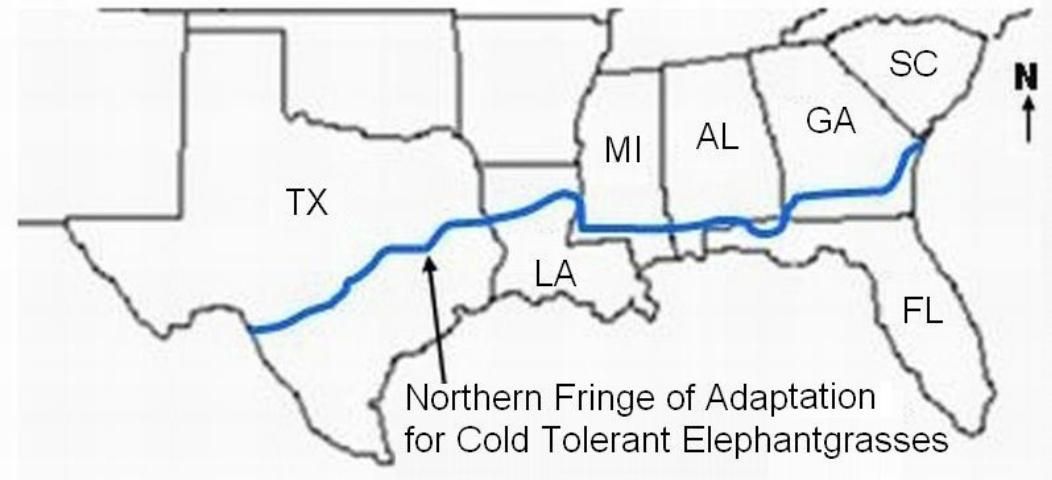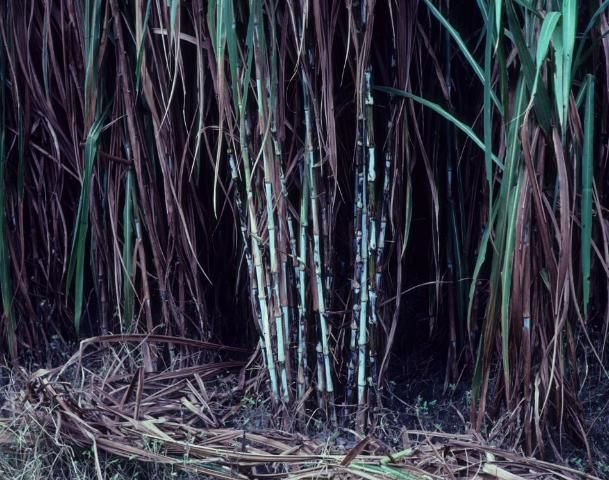Production of Biofuel Crops in Florida: Elephantgrass
Introduction
Elephantgrass (Pennisetum purpureum) was first introduced into the United States from Africa in 1913. Prior to 1960, research in Florida focused on elephantgrass as potential forage for cattle. A new research initiative emerged following the oil embargo of 1973. In the 1980s, funding for renewable energy became available through an agreement between the University of Florida Institute of Food and Agricultural Sciences and the Gas Research Institute of Chicago, Illinois. A major objective was to identify herbaceous plants with the highest biomass yield. Early on it became clear that elephantgrass was a premier biomass plant. After 15 years of field trials conducted in Florida, as well as trials in southern Alabama and Georgia, five of the best elephantgrass selections for biomass energy were planted in a holding nursery in 2000 at the Plant Science Research and Education Unit near Citra, FL, by Dr. Gordon M. Prine.
The nursery included Merkeron, N51, N43, N13, and PI 300086 elephantgrasses. Merkeron, N51, N43, and N13 yielded well throughout Florida and have the potential to grow as perennials in the lower southeastern US. Selection PI 300086 is high yielding, but stands can be reduced by the more severe winters in North Florida. For cold-tolerant selections, the northern limit for sustained survival and adequate yield is where temperatures do not drop below 15°F to 20°F or -6.7°C to -9.4°C.

Credit: K. Woodard, UF/IFAS
Current Potential for Use as Biofuel
In the 1980s, energy conversion strategies included the use of elephantgrass as a feedstock for methane generation or co-firing it with coal to produce electricity. In recent years there has again been interest in the production of cellulosic ethanol. The feasibility of producing ethanol from crops such as elephantgrass has increased because there have been improvements in fermentation strains and in methods for generating sugars from cellulosic feedstocks, and the cost of enzymes used to break down cellulose has decreased. In some cases, economic incentives for cellulosic ethanol production have existed due to high oil prices and the resulting increase in governmental programs to encourage renewable energy.

Credit: Forage Extension, UF/IFAS
Biology of Elephantgrass
Elephantgrass is an erect, perennial bunchgrass with large, hardened stems at maturity. Although dwarf and intermediate types exist, tall-growing selections produce the highest biomass yield when allowed to grow the entire warm season. From April through October, the coarse stems increase in length and weight, reaching heights of 18 feet. Spike (cattail) seed heads emerge from late October through November for most selections. Seeds are small, quickly lose viability, and are genetically diverse; therefore, elephantgrass is propagated vegetatively.
Production
While the highest production has been reported on moderately-drained, lowland soils, elephantgrass is relatively drought tolerant and can produce good yields on excessively-drained, deep sands. Though clump sections can be dug and used for planting, elephantgrass is primarily propagated with 3- to 4- node (bud) pieces cut from the hardened portion of the stem. Pieces planted horizontally in furrows should be covered with no more than 2 to 3 inches of soil. Three-node stalk pieces can also be placed into the soil at a 45-degree angle with the uppermost node exposed. To produce quality planting material, nurseries should be fertilized in the spring with a minimum of 100 lb of N per acre. Phosphorus and potassium should be applied based on soil test. For northern Florida, stalk pieces can be planted in August or from late October until the first killing freeze. When planted in the summer, elephantgrass should be allowed to accumulate biomass without harvest throughout the remaining growing season to ensure winter survival. The planting time is less critical, though, for southern Florida. In both cases, the seedbed should be thoroughly prepared and rows should be 3 to 5 feet apart. For large operations, machinery used to plant sugarcane stalk pieces can be adapted for elephantgrass. Both summer and fall plantings can be harvested for biomass during the following growing season.

Credit: Forage Extension, UF/IFAS
Potential Yields
In north-central Florida, the highest dry biomass yields have exceeded 20 tons/acre/year. Average production for full-season elephantgrass should range from 14 to 18 tons/acre. Yield depends greatly on the amount and distribution of rainfall and fertilization rate. For full-season growth, elephantgrass should be fertilized with 150 to 300 lb of N per acre in the spring in two split applications. Elephantgrass can also be harvested twice yearly. Annual yield will generally be 10 to 20% lower and nutrient removal in harvested biomass twice as great with two versus one harvest per year, but the biomass from two harvests will be more easily converted to methane or ethanol. For two harvests per year, apply 100-150 lb of N per acre in the spring and again after the first harvest.
Production Challenges
Major production challenges are the initial expense of establishment and the high N rates needed to produce high biomass yields. The cost of establishment can be reduced somewhat by mechanizing planting operations. By using alternative nutrient sources (e.g., biosolids, livestock manures, and industrial byproducts), the high cost of chemical fertilizers can also be reduced.
Estimated Production Costs
In 2003, the total variable cost to establish one acre of elephantgrass with hand labor was estimated to be $530 (see Energy from Crops: Production and Management of Biomass/Energy Crops on Phosphatic Clay in Central Florida at https://edis.ifas.ufl.edu/eh213). This estimate included a fertilization N rate of 200 lb/acre using ammonium nitrate. While a higher cost can be expected currently, it should be noted that establishment costs can be amortized over the life of the stand, and under good management elephantgrass is a long-lived perennial. With established stands, major production costs include fertilization and harvesting.
Environmental Concerns
As with all crops that require N fertilization and are grown on Florida's sandy soils, nitrate leaching is an environmental concern. Also, elephantgrass is currently on the "do not plant" list for Florida due to its potential for invasiveness. Recent research has compared invasive potential of naturalized elephantgrasses that have been found growing as weeds throughout Florida with that of elephantgrasses selected for high biomass production. Clones selected for use as biomass crops flower much later than in fall than naturalized populations, and some do not flower before frost in most years. This reduces invasive potential markedly, as seed is the primary agent of spread. In addition the selected elephantgrass types differ widely in morphology and physiological response from naturalized populations. When considered in total, these data support a conclusion that invasive risk assessment of elephantgrass should occur at the level of the cultivar or breeding line rather than assuming that all members of the species are similarly invasive.
Summary
Elephantgrass is the highest-yielding, best-adapted perennial grass for biomass production in Florida. Currently, however, there are no commercial facilities converting elephantgrass to bioenergy, so planting for bioenergy purposes cannot be recommended.
References
Prine, G. M., L. S. Dunavin, B. J. Brecke, R. L. Stanley, P. Mislevy, R. S. Kalmbacher, and D. R. Hensel. 1988. "Model crop systems: Sorghum, napiergrass." (p. 83–102). In Methane from biomass: A systems approach. Edited by New York: Elsevier.
Sollenberger, L. E., K.R. Woodard, J. M. B. Vendramini, J. E. Erickson, K. A. Langeland, M. K. Mullenix, C. Na, M. S. Castillo, M. Gallo, C. D. Chase, and Y. López. 2014. "Invasive populations of elephantgrass differ in morphological and growth characteristics from clones selected for biomass production". Bioenergy Res. 7:1382–1391.
University of Florida, Institute of Food and Agricultural Sciences. 2018. "Assessment of Non-native Plants in Florida's Natural Areas" (https://assessment.ifas.ufl.edu, 4/29/2019) Gainesville, FL, 32611-4000, USA.
Woodard, K. R., G. M. Prine, and W. R. Ocumpaugh. 1985. "Techniques in the establishment of elephantgrass (Pennisetum purpureum Schum.)." Soil Crop Sci. Soc. Fla. Proc. 44: 216–221.
Woodard, K. R., and G. M. Prine. 1990. "Propagation quality of elephantgrass stems as affected by the fertilization rate used on nursery plants." Soil Crop Sci. Soc. Fla. Proc. 49: 173–176.
Woodard, K. R., and G. M. Prine. 1993. "Regional performance of tall tropical bunchgrass in the southeastern U.S.A." Biomass and Bioenergy 5: 3–21.
Woodard, K. R., and G. M. Prine. 1993. "Dry matter accumulation of elephantgrass, energycane, and elephant millet in a subtropical climate." Crop Sci. 33: 818–824.



